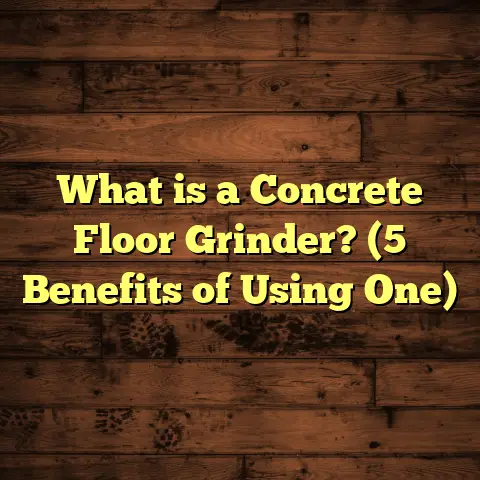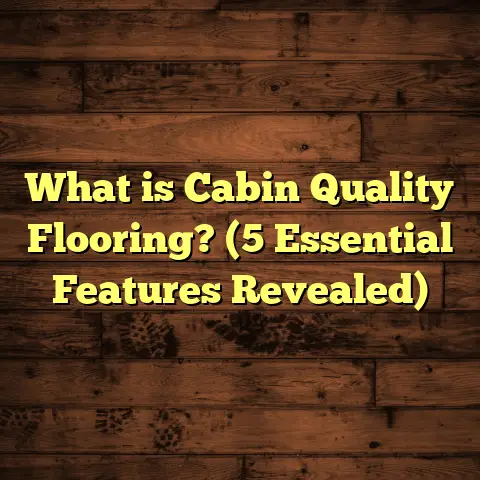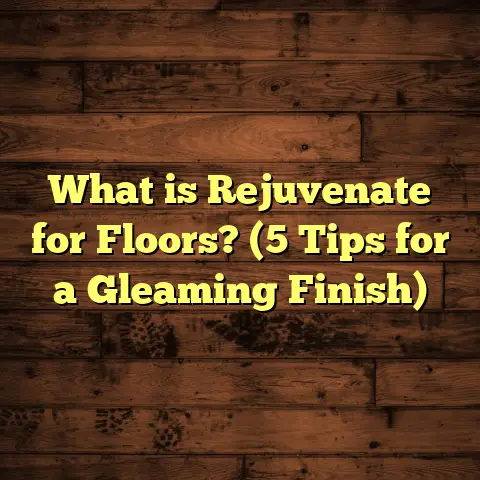What is Flagstone Flooring? (5 Benefits for Your Home)
Expert Tip Before We Start
If you’re thinking about adding a natural touch to your home flooring, here’s a tip I’ve learned from years of experience: When installing flagstone flooring, always take your time selecting each stone. The variation in colors and textures is what makes flagstone unique, so handpick stones that complement each other—this little step can save you from a patchy look later.
What is Flagstone Flooring?
You might be wondering, what exactly is flagstone flooring? Simply put, flagstone refers to flat slabs of natural stone that are cut or split into thin layers. These stones are commonly used for paving walkways, patios, and yes, flooring inside or outside homes. The most popular types include sandstone, slate, limestone, and bluestone. Each type has its own unique color palette and texture, which gives flagstone flooring its signature earthy and rustic appearance.
Flagstone is not a single stone but a category of stones that are flat and suitable for flooring. Because it comes from nature, no two pieces are identical, which means your floor will have character and individuality.
The thickness of flagstone typically ranges from 1 to 3 inches (2.5 to 7.5 cm), which provides durability and a substantial feel underfoot. The stones are quarried in large slabs and then split into thinner pieces along natural cleavage planes.
How I Use Flagstone Flooring in Homes
I’ve installed flagstone floors in dozens of homes, and one thing I always recommend is using it in spaces where durability and style matter equally. It works great in entryways, sunrooms, kitchens, and outdoor patios. I once worked on a home where the client wanted a floor that could handle heavy foot traffic but still looked warm and inviting. Flagstone was perfect for that.
One of my favorite projects involved a kitchen remodel where the original tile was cold and uninviting. We switched to bluestone flagstone—its natural blue-grey tones added warmth and depth. The homeowners loved not only the aesthetics but also how easy it was to keep clean.
Beyond aesthetics and durability, flagstone brings an element of natural cooling because stone retains less heat compared to synthetic materials. In warmer climates, this can help keep your home cooler during hot seasons without extra energy use.
Installation Tips That Make a Difference
Installing flagstone isn’t like laying down typical tiles or hardwood planks. Because these stones vary in size and shape, installation requires a bit more patience and skill.
Surface Preparation
Before laying the stones, I always make sure the base is properly prepared. This usually means compacting a gravel bed to prevent shifting over time. Concrete can also be used as a base in some cases for indoor installations.
For outdoor surfaces, drainage is critical. A well-prepared base prevents water pooling under the stones, which can cause shifting or frost damage in colder climates.
Dry-Laying First
I recommend dry-laying the stones first—arranging them without mortar—to get a sense of how they fit together. This helps visualize grout lines and pattern flow. Dry-laying also lets you adjust spacing to avoid gaps that are too large or uneven.
This step cannot be overstated! I’ve seen rushed jobs where installers skipped this part and ended up with awkward gaps or mismatched colors that made the floor look disjointed.
Mortar vs. Sand Jointing
For outdoor patios or paths, sand jointing works well because it allows water drainage. Indoors or areas needing sturdier footing usually call for mortar between stones to lock them in place.
Mortar installation requires some skill—it must be mixed correctly and applied evenly to avoid cracking or loose stones later on.
Sealing
After installation, sealing flagstone is key for maintenance and longevity. A good sealant protects against stains and moisture while enhancing the stone’s natural colors. I use penetrating sealants that don’t peel or crack over time.
Sealing also helps repel oils, wine spills, or dirt that can otherwise penetrate porous stone surfaces.
Caring for Your Flagstone Floor
Maintaining flagstone flooring isn’t hard if you follow a few simple steps.
- Regular Sweeping: Dirt and grit can scratch the stone surface over time.
- Gentle Cleaning: Use pH-neutral cleaners or mild soap with water; avoid acidic cleaners that can erode the stone.
- Resealing: Depending on foot traffic and exposure, reseal every 1-3 years to keep your floor protected.
- Addressing Stains Quickly: Oil spills or food stains should be cleaned up promptly to avoid permanent marks.
I once had a client who neglected resealing their floor and ended up with dull patches after a few years. Regular upkeep really keeps flagstone looking fresh.
5 Benefits of Flagstone Flooring for Your Home
Now let me share five reasons why flagstone flooring might be the right choice for you.
1. Natural Beauty That Lasts
No man-made material can match the natural charm of flagstone. Each slab carries unique colors and textures formed over millions of years. When installed well, it creates an organic feel that blends perfectly with indoor plants, wooden furniture, or even modern décor.
Flagstone comes in a variety of earthy tones—from rust reds to cool greys—and its irregular shapes add character impossible to mimic with manufactured tiles.
2. Durability You Can Count On
Flagstone is incredibly sturdy. On average, sandstone and bluestone rate between 6-7 on the Mohs hardness scale (with diamond at 10). This means they resist scratching and chipping much better than softer materials like marble or limestone alone.
In practical terms, I’ve seen flagstone floors last decades with minimal wear—even in high-traffic commercial settings like cafes or galleries.
3. Versatility Both Indoors and Outdoors
Flagstone’s thickness and slip resistance make it ideal for many applications. You can seamlessly extend your indoor floor to an outdoor patio with matching stone for a cohesive look.
Plus, it handles weather changes well outdoors—freeze-thaw cycles don’t tend to damage quality flagstone if installed properly with good drainage.
4. Low Maintenance Costs Over Time
While initial costs can be higher than vinyl or laminate, flagstone’s longevity means fewer replacements or repairs down the line. Compared to hardwood that might scratch or warp over time, flagstone stays strong without much fuss.
I track maintenance costs on projects I manage, and flagstone floors typically require less than half the upkeep budget over 10 years compared to engineered wood flooring.
5. Eco-Friendly Flooring Option
Since flagstone is natural stone quarried directly from the earth without heavy processing, it has a smaller environmental footprint than synthetic flooring materials.
Using local stone further reduces transportation emissions. If you care about sustainability in your home design, flagstone checks that box nicely.
Breaking Down Flagstone Types: Which One Fits Your Home?
Not all flagstones are created equal. Knowing your options helps you match functionality with style.
Sandstone
Sandstone is one of the most common types used in flagstone flooring because of its warm colors—reds, browns, yellows—and slightly rough texture that offers good traction.
It’s relatively soft compared to other stones but still durable enough for moderate traffic areas inside your home or outside patios.
Bluestone
Bluestone is prized for its bluish-gray hues and smooth finish. It often comes from quarries in New York and Pennsylvania in the U.S., making it popular in American homes.
Bluestone holds up well to weather changes outdoors but can be more expensive due to limited sources.
Slate
Slate has a distinct layered look with colors ranging from black to greenish or purplish tones depending on origin. It tends to be thinner than sandstone or bluestone but very durable.
Slate’s natural cleft finish gives floors a textured appearance that’s great for high-traction needs like bathrooms or entryways.
Limestone
Limestone offers softer shades—beige, cream—that brighten indoor spaces beautifully. It’s fairly porous though, so sealing is especially important here to avoid staining.
Limestone works well in low-traffic areas like bedrooms or formal living rooms where you want elegance without heavy wear.
My Experience Handling Different Flagstones
I remember working on a project where the homeowner couldn’t decide between sandstone and slate for their outdoor patio. They were worried about slipperiness when wet.
After testing samples underfoot wet and dry, we opted for sandstone because its rougher texture offered better grip without sacrificing warmth in color.
Another time, a client chose limestone indoors but forgot to reseal regularly—the floor absorbed some red wine stains that took months to fade despite professional cleaning efforts. That taught me how critical maintenance is depending on stone type.
Detailed Look at Installation Process: Step by Step
If you’re curious about what goes into installing your flagstone floor, here’s how I usually approach it:
- Measure & Plan: Calculate square footage precisely; factor in overage for cuts and waste (usually about 10%-15%).
- Choose Stone: Pick stones that fit your style—consider color consistency versus variety based on room mood.
- Prepare Base: Excavate area if outdoors; compact gravel base or lay concrete slab indoors.
- Dry Layout: Place stones loosely on base to find optimal arrangement; adjust for gaps between 1/4” to 1/2” depending on joint style.
- Set Stones: Use mortar bed or sand joints; level stones so surface is even but retains natural irregularities.
- Grout & Seal: Fill joints with grout or sand; once dry apply sealer evenly across surface.
- Cure Time: Allow floor to cure completely before heavy use—usually 48-72 hours minimum.
What Makes Flagstone Different from Other Natural Stones?
You might ask why choose flagstone instead of marble or granite? Here are some differences I highlight:
- Texture: Flagstones have natural cleft surfaces offering more grip versus polished marble’s slickness.
- Cost: Generally more affordable than granite or marble slabs.
- Aesthetic: Rustic and organic versus formal elegance.
- Thickness & Weight: Flagstones are thicker slabs good for flooring; marble tiles are thinner.
- Porosity: Flagstones tend to be more porous requiring sealing but allow breathability preventing moisture trapping underfoot.
Real Data: Flagstone Longevity & Durability Stats
From my experience combined with industry data:
- Flagstone floors can last anywhere from 30 to 50+ years when installed properly.
- Hardness ratings (Mohs scale): sandstone ~6-7; slate ~5-6; limestone ~3-4.
- Slip resistance: Natural cleft finishes offer an average coefficient of friction (COF) around 0.6-0.8 (higher means less slippery).
- Maintenance cost comparison (over 10 years): Flagstone $5-$10/sq ft vs hardwood $12-$20/sq ft (due to refinishing needs).
Case Study: A Flagstone Patio Transformation
Let me share one project that really stuck with me:
A family in Oregon wanted a backyard patio that felt like an outdoor living room but could withstand rain and winter freeze-thaw cycles without cracking or shifting.
We selected thick bluestone slabs quarried locally for durability plus aesthetic fit with their house color palette.
Installation took about two weeks including base prep, dry layout adjustments (they loved mixing large slabs with smaller filler pieces), mortar setting, then sealing twice before use.
After one year, they reported zero issues with stone lifting or discoloration despite heavy rains—including muddy kids running through!
This project showed me how top-quality materials combined with careful installation ensure years of enjoyment with minimal hassle.
Common Questions I Get About Flagstone Flooring
Q: Can I install flagstone myself?
A: If you’re handy with tools and patient enough for dry fitting stones carefully, yes. But for best results—especially outdoors—I recommend professional help due to base prep and mortar work complexity.
Q: Will flagstone feel cold?
A: Yes, natural stone tends to feel cooler than wood or carpet underfoot—but this can be pleasant in warm climates or balanced with rugs indoors.
Q: How do I prevent weeds growing between outdoor flagstones?
A: Proper sand jointing with polymeric sand or sealed grout prevents weed seeds from settling into joints outdoors.
Q: Is flagstone slippery when wet?
A: Natural cleft textures reduce slipperiness significantly compared to polished stone surfaces—but always exercise caution on outdoor wet floors.
Enhancing Your Space With Flagstone Design Ideas
You don’t have to stick to traditional layouts when using flagstone flooring—I love mixing shapes and sizes to create visual interest!
Try these ideas:
- Random Pattern: Vary sizes naturally for rustic charm.
- Geometric Shapes: Use uniform rectangular slabs arranged in repeating patterns.
- Mixed Materials: Combine flagstone with wood borders or gravel paths outdoors.
- Color Gradients: Select stones ranging light-to-dark creating soft transitions.
- Indoor/Outdoor Flow: Extend same stone from inside living room out onto patio visually expanding space.
Each option changes the vibe dramatically—from casual cottage feel to sleek modern minimalism—showing how versatile flagstone really is.
Final Thoughts from My Flooring Journey
Through all my projects installing flagstone floors in different homes across climates—from humid southern states to chilly northern regions—I’ve learned this: Flagstone isn’t just flooring material; it’s a design statement grounded in nature’s art combined with practical resilience.
If you want floors that tell stories over time—wearing character rather than fading away—flagstone delivers that beautifully without losing function underfoot.
It requires care during installation and maintenance but rewards homeowners with decades of durable beauty unmatched by synthetic alternatives.
So if you’re thinking about adding something special underfoot that ages gracefully while being kind to the environment—flagstone is definitely worth considering.
If you want help figuring out which type fits your home best or need help estimating costs accurately based on your region, just let me know! I’m always happy to chat about flooring options tailored specifically for your lifestyle and space.





